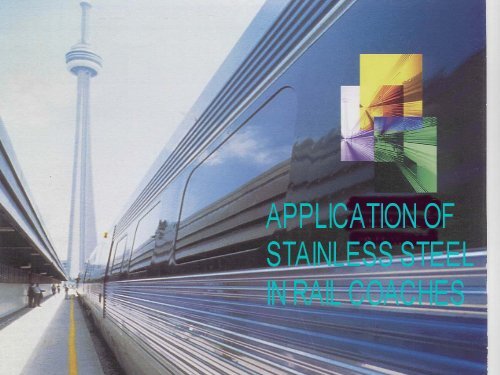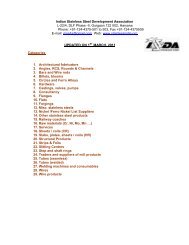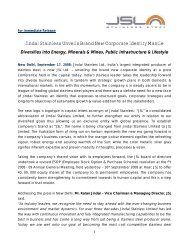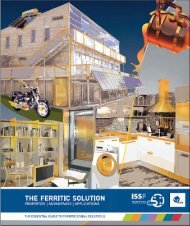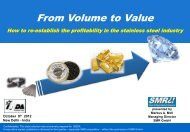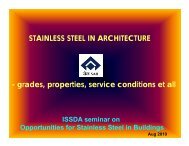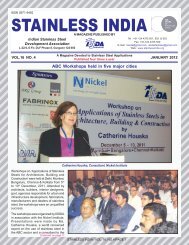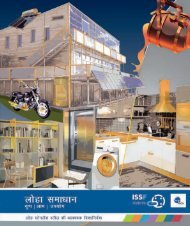Evolution Of Steel Body Coaches - Indian Stainless Steel ...
Evolution Of Steel Body Coaches - Indian Stainless Steel ...
Evolution Of Steel Body Coaches - Indian Stainless Steel ...
- No tags were found...
Create successful ePaper yourself
Turn your PDF publications into a flip-book with our unique Google optimized e-Paper software.
<strong>Evolution</strong> of <strong>Steel</strong> <strong>Body</strong> <strong>Coaches</strong> Aspects to be considered forselection of material. Why <strong>Stainless</strong> <strong>Steel</strong> Use of <strong>Stainless</strong> <strong>Steel</strong> in Rail<strong>Coaches</strong> – Present Scenario. Future Scope Quality Issues Conclusion.
EVOLUTION OF STEEL BODYCOACHES Rail coach building technology undergone asea change over the years Earlier generation of rail coaches – woodenbody over heavy steel underframes Later steel body coaches with rivetedconstruction developed In 1955, ICF manufactured “all steel” coachbody with all welded construction. Thesecoaches incorporated anti-telescopic telescopic endconstruction to withstand high impact loadsto ensure safety for passengers
ASPECTS CONSIDERED WHILESELECTING MATERIAL FORAPPLICATIONS IN RAILWAYS DURABILITY SAFETY LOW MAINTENANCE COST
STAINLESS STEEL – THE IDEALMATERIALThe following unique characteristics makestainless steel a designer’s delightCORROSION RESISTANCESTRENGTHTOUGHNESS AND IMPACT RESISTANCEFORMABILITYHEAT HEAT RESISTANCEBETTER BETTER AESTHETIC LOOKLOW LOW ON MAINTENANCELONG LONG TERM VALUE
CORROSION RESISTANCE<strong>Stainless</strong> steel can resist corrosion in coastal, saline,and other chloride bearing environment.This characteristic singularly accounts for manytechno-economic economic advantages like-Savings on constructionProtection against rustLesser weightAllowance for corrosion reducedReduced maintenance requirements and less‘Down Time’
STRENGTH<strong>Stainless</strong> steel has–High tensile strength–Excellent fatigue properties and–GoodweldabilityHigher strength to weight ratio of stainlesssteel makes weight reduction of structurespossible, resulting in energy savings.
TOUGHNESS AND IMPACTRESISTANCE <strong>Stainless</strong> steel of certain grades have high toughnessfrom elevated temperatures to sub zero temperatures. <strong>Stainless</strong> steel is a good absorber of energy andtherefore exhibits higher impact strength.Nickel-containing containing stainless steel is not only strongerthan carbon steel or aluminum but also absorbs 2.5times more energy than carbon steel when deformed.This makes it ideal for making safe passengercompartments with the coach ends designed to absorblarge amounts of energy if deformed by collision.
FORMABILITY It is possible to bend and form differentshapes
HEAT RESISTANCE Special high Chromium and Nickelalloyed grades resist hightemperature and retain strength inelevated temperatures at 1100° c andresists breakdown or collapse ofstructure. This gives valuable time forevacuation of passengers in case offire. Since Nickel containing stainless steeldoes not need painting, the threat ofnoxious fumes is minimized.
BETTER AESTHETIC LOOK This is one single characteristicwhich scores over othermaterials. <strong>Stainless</strong> steel bodiedcoaches do not normally requirepainting and provides goodaesthetic appearance. By carefulselection of surface finish indifferent patterns, stainless steelcan form excellent material forfurnishing interior coaches.
LOW ON MAINTENANCE<strong>Stainless</strong> <strong>Stainless</strong> steel normally requiresonly a periodic wash with soap andwater to maintain its originalfinish.
LONG TERM VALUEWhen When the total life cyclecosts are considered,stainless steel is often theleast expensive materialoption available.
AREAS SUBJECTED TO HIGH RATE OFCORROSION IN PASSENGER COACHES Trough floor:Areas adjacent to lavatory, door ways, below thelongitudinal partition, luggage compartments and kitchenarea of pantry car. Side wall bottomAreas below lavatory and between body side pillars. Sole BarSole bar in the lavatory area and door ways. <strong>Body</strong> PillarsBottom portion of the pillar near door ways and lavatoryarea.(continued)
Cross bearersJoint between sole bar and cross bearers. Air reservoirCorrosion due to abrasive action due to dust and sand. Battery BoxesCorrosion due to acid action. RoofArea around the ventilator opening.
HISTORY OF MATERIALS USEDBY ICFSHEETSPLATESSince inception(1955)Since 1967Since 1976During 89-90Trial)Deep drawn sheets toDIN 1623 Grade St.VIIb/23IRS: M 36 (Mild <strong>Steel</strong>)IRS: M 41 Corten <strong>Steel</strong>(Low Alloy high tensile)For trough floor(Austenitic <strong>Stainless</strong> steel)to AISI 301Above 4.75 mm thick HotRolled to DIN 1621 GradeSt.37-21DIN 1621 St. 37-21 &IS: 2062-67, 42 WCIRS: M 41 &IS: 2062-67, 42 WC
Switch over from mild steel tocorten steel increased the servicelife from 5-656 years to 7-107years. However, the coach requiresmajor corrosion repairs 2 or 3times in its life cycle of 25 years.
Use of stainless steel has been introduced in the coachbody construction for various components. These are:Trough floor-1.7mm thick to Specn. . AISI 301 with 2B/2Dfinish
<strong>Stainless</strong> steel Lavatory Inlay -2mm thick to Specn. . AISI 304 with 2D finish
Pantry Car Side wall, roof and partition in the kitchen areato Specn. . AISI 304
CounterView of Kitchen area
AC Duct of Jan Shatabdi coaches1mm thick Hammer Tone finish to Specn. . AISI 304
Rail Mart and Mini Pantry of Jan Shatabdi <strong>Coaches</strong> Side wall partition - stripe finish Roof - Hammertone finish Floor - Moon Rock finish
<strong>Stainless</strong> <strong>Steel</strong> Paneling in I AC Toilets
End Wall Panelling
SS Hand Rail, Cross Bars
Luggage Rack
Hyderabad Metro – Rainwater Gutter
<strong>Stainless</strong> <strong>Steel</strong> Hand Hold
COMPOSITE STEEL SHELL ICF manufactured 3 Pantry Cars during 1996 with compositesteel shell using stainless steel of different grades.The stainless steel used in various parts of composite coachesare –Sole Bar5mm thickSS.409M<strong>Body</strong> Pillar2mm thickSS.409MTurn under and lower side wallsheet upto 450mmTrough floor2mm thick1.7mm thickSS.409MSS.301Toilet Inlay1.6mmSS.304Approximately 3.8 metric tones of stainless steel used for each shell
CANT RAIL (CORTEN STEEL M-41) MBODY PILLAR S.S (409-M)
Service trials conducted on thesecomposite steel shell indicatesatisfactory performance. This design will be implemented forall the future pantry cars.
ALL STAINLESS STEEL SHELL Two Proto Type shells made of all stainless steelwere manufactured during 1999-2000 Approximately 11 metric tones of stainless steelused in the coach body construction. <strong>Stainless</strong> steel was used for –– Underframe– Trough floor– Side Wall– End wall– Roof
IMPROVED EMU SHELLIn order to minimize the corrosion problem and reduce thefailure of coach components, an improved EMU Shell hasbeen designed incorporating use of Ferritic/Austeniticstainless steel for the following components.Sole Bar - 6mm AISI 409M<strong>Body</strong> Pillar - 2mm AISI 409MSide wall sheet upto - 2mm AISI 409Mwindow levelTrough floor - 1.7mm AISI 301Floor sheet of - 2.5mm AISI 430Vendor compartmentA prototype shell has been manufactured and successfullytested by applying squeeze loads at the coach ends.
IMPROVED EMU SHELL
stainless steel for fire proofing ofcoaches In order to improve the fireresistance of coaches a number ofmeasures have been taken on trialbasis. These include use of stainlesssteel in the coach construction.
<strong>Stainless</strong> steel cladded compreg hasbeen used in the following areas ofprototype coaches. 0.5mm thick stainless steel (304) claddedwith 3mm compreg for wall panellingand partitions – Fabrique finish 0.5mm thick stainless steel (304) claddedwith 12mm compreg for flooring –Macromatt finish
<strong>Stainless</strong> <strong>Steel</strong> Sidewall
<strong>Stainless</strong> <strong>Steel</strong> Doorway
<strong>Stainless</strong> <strong>Steel</strong> Partition
A view of Sleeper coachwith <strong>Stainless</strong> <strong>Steel</strong> Panelling
Sl.NOSize (mm)SpecificationFinish11x1250x3500AISI 304421x1220x2440AISI 304HAMMERTONE31x1220x2440AISI 304STRIPE41x1250x2500AISI 304HONEYCOMB51x1250x2500AISI 304CANVAS61.7x1250x3500AISI 3012D71.7x1250x2900AISI 3012D81.7x1250x1900AISI 3012D92x1200x2900AISI 3012B102x1200x2150AISI 3012B112x1250x3500AISI 409M2B122.5x1250x3000AISI430MOONROCK133.2x1000x2000AISI 3012D145x1200x2600AISI 3012D155x1250x2600AISI 409M2D166x1250x2600AISI 409M2D
Consumption of <strong>Stainless</strong> <strong>Steel</strong> atICF(in tonnes)2000-200120012001-200220022002-200320032003-200420042004-20052005(upto15.08.04)12020010001460460
Use of stainless steel is likely to be extended for the following– Sole Bar
<strong>Body</strong> side Pillar -2mm thick to Specn. . AISI 301
<strong>Stainless</strong> partition below seat/berth
<strong>Stainless</strong> <strong>Steel</strong> Double Ferrule Fittings
S.S FITTINGS
S.S FERRULE
S.S TUBE
MANUFACTURE OFSTAINLESS STEELCOACHES AT ICF – FUTUREThis requires upgradation ofmachinery and plant for stainlesssteel fabrication
The following equipments have beenplanned for procurement:Laser cutting and welding machine forside wallLaser cutting machine for componentsCNC Spot Welding MachinePulse MIG Welding PlantsRobotic Welding Plant
EXPORT ICF has bagged an Export order for11 Meter Gauge Air Conditioned<strong>Stainless</strong> coach shells for Malaysia
<strong>Stainless</strong> <strong>Steel</strong> AISI 301 is used formanufacture of the following shellcomponents. Trough Floor <strong>Body</strong> pillar Cant rail Car lines Side wall Sheet End wall including end stancheon Door corner pillars Roof sheets <strong>Body</strong> stiffeners Underslung water tanks
COACHES FOR MUMBAI RAILVIKAS CORPORATION(MRVC) ICF has manufactured three prototypecoaches with all stainless steel shells tograde AISI 301.
LIST OF COMPONENTS MADEOUT OF S.S FOR EMU COACHESFOR MRVC Sole Bar Trough floor <strong>Body</strong> pillar Side wall Roof End wall
contd..LIST OF COACH COMPONENTS MADE OUT OFSTAINLESS STEEL FOR EMUFOR MRVCDoorway framePillarsDeck sheet in vendors compartmentCentral ductGrab pole / rail / Hand holdSeat frameDoorway partitionBulk head partition
STAINLESS STEEL SEATFRAMES
<strong>Stainless</strong> <strong>Steel</strong> doorway partition
<strong>Stainless</strong><strong>Steel</strong>Doorwaypartition(MRVC)
<strong>Stainless</strong>steelpartpartition
<strong>Stainless</strong> steelprotectivewindowscreen for AC-DC EMU
<strong>Stainless</strong> steel grab rail with SShand hold
<strong>Stainless</strong> steelBulk headpartition forMRVC
RCF have already commenced manufacture of these coacheswith stainless steel body. ICF will also manufacture thesecoaches in a few years time.
QUALITY ISSUES Poor quality of stainless steel supplied byindustry, re-processed and re-cycled materialwith sub-standard standard quality supplied as genuinematerial. Inadequatenumber of manufacturers ofstainless steel in India
Squareness of thesheets suppliedSquareness of the sheets andquality of special finish is veryimportant. Sometimes we comeacross problems on thisparameters. Proper care shouldbe taken by manufacturers tomaintain the squareness of sheetssupplied.
While specified Chemicalproperties and physicalproperties such as tensilestrength, yield strength etc.,are achieved, requirementwith regard to elongation isnot met.
Material for <strong>Stainless</strong> <strong>Steel</strong>Tube and Rod <strong>Stainless</strong> <strong>Steel</strong> tubes are normally procuredto IS:6913 Gr.`B’ with Nickel percentage 9to 13%. Supplies have been received withNickel content ranging form 8 to 10.5%.The same problem is noticed with <strong>Stainless</strong><strong>Steel</strong> wire and rod to specification IS 6528Gr. O 4 Cr.18 Ni.10. The specification mayrequire review.
Presently Presently ICF is procuring <strong>Stainless</strong> <strong>Steel</strong>from:–Salem <strong>Steel</strong> Plant (SAIL) / Salem–JindalStrips / Hissar<strong>Stainless</strong> <strong>Stainless</strong> <strong>Steel</strong> component/equipmentsuppliers have been directed to obtain the<strong>Stainless</strong> <strong>Steel</strong> only from the abovesources.
The component suppliers are unable toprocure raw materials in small quantitiesfrom the above manufacturers. In manycases, the firms supply materialconforming to 200 series in place of 300series. Mixing up of materials of differentgrades reported.
ICF procures <strong>Stainless</strong> <strong>Steel</strong>under the following two heads1. <strong>Stainless</strong> <strong>Steel</strong> Sheets and platesprocured as raw material directlyfrom manufacturers2. The processed stainless steelcomponents procured fromvendors.
SOLUTIONMajor producers such asM/s. SAIL & M/s. Jindalshould clearly indicate whoare authorised retailers toavoid quality problems.
PROBLEMS FACED WELDING OF STAINLESS STEEL Hot cracking during welding of Austeniticstainless steel Diffusion of carbon while welding Mild steelwith stainless steel - likely to cause corrosionproblem. Conventional welding processes to be replacedby modern welding techniques requiring inputof Machinery & Plant involving high costs.contd..
Indigenous availability of Qualityconsumables. Flux cored wire is notavailable indigenously. Consultancy for upgrading the skill,process to be adopted for tacklingstainless steel.
Assistance required Special training of Artisans andsupervisors for welding of stainlesssteel.
ICF is procuring stainless steelsheet to thickness 0.8 mm, 1mmand 2.5mm to various grades offinish such asStripeHonykomMoon RockHammertoneMacromattFabrique
VariousPatternsused
<strong>Stainless</strong> <strong>Steel</strong> ofspecial finish There is only one supplier viz., M/s.SAIL/Salem for <strong>Stainless</strong> steel ofspecial finish.
Inter-face between <strong>Stainless</strong> steelmanufacturers, ICF and <strong>Stainless</strong><strong>Steel</strong> fabricatorsClose coordination is required between <strong>Steel</strong>manufacturer, Component processors and ICFi.e. purchaser to identify, locate and developgenuine and efficient fabricators andsuppliers of <strong>Stainless</strong> <strong>Steel</strong> items, so thatquality products can be supplied to ICF.
CONCLUSION There is tremendous scope for use of stainless steelin rail coach construction in India. There is anincreasing trend in use of stainless steel for thecoach fittings and ICF is switching over from zinccoated/powder coated/galvanized components tostainless steel. Success of application of stainless steel in <strong>Indian</strong>Railways depends on the capability of suppliers tosupply quality material in sufficient quantities.


